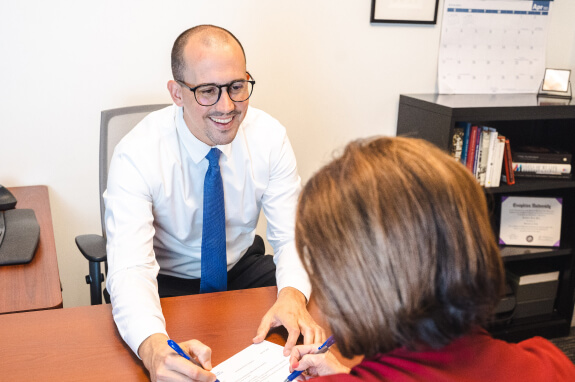Tax Planning
Benefits of Tax Planning
A good tax plan means keeping more of your paycheck. It also means keeping more of your profits and principal in retirement. The right strategy will lower your taxes this year and over your entire lifetime.
Cut Your Income Taxes
Keep more of your paycheck and achieve financial independence faster.
Cut your Portfolio Taxes
According to Vanguard, asset location can lower your taxes by up to 0.75% worth of your portfolio value per year. That’s $7,500 per year in taxes on a portfolio of $1,000,000. Your Spending Order in retirement can lower your taxes by up to 1.1% worth of your portfolio value per year. That’s $11,000 per year in taxes on a portfolio of $1,000,000.
Help your Beneficiaries
Gifts of after-tax money go much further in benefitting your heirs. The difference between a pre-tax and after-tax inheritance of $1,000,000 is equivalent to a downpayment on a beautiful home.
What is Tax Planning?
We can’t eat pre-tax returns – so taking action to maximize your after-tax return is critical. As Judge Learned Hand once said, “Anyone may arrange their affairs so that their taxes shall be as low as possible.” Working with a tax planner allows you to utilize every legal method for reducing your tax bill.

How Farnam Financial Approaches Tax Planning
As tax planning advisers we look at your finances holistically. We start by listening to your goals and understanding your current finances. Next, we’ll look at all opportunities to reduce your taxes now and over your lifetime. In making recommendations, we will always coordinate advice with your CPA or tax advisor to ensure we’re working together with the common goal of helping you succeed. Here are a few of the strategies and tools we use for your benefit:
Deductions and Credits
We’ll look to capture 401k deductions, IRA deductions, 529 deductions (AZ State deduction available), Solar Tax Credits, Charitable deductions, Rental property depreciation, and more.
Tax-Loss Harvesting
When investing in a taxable (Brokerage) account, temporary drops in the market can benefit you. Tax-loss harvesting allows you to sell an investment at a loss, use the proceeds to buy something else, and capture a deduction. This deduction can offset capital gains and eliminate that tax. It can also be applied to your ordinary income in that year (up to $3,000 per person per year).
Asset Location
For retirees and near-retirees, choosing what account types to place your different investments has significant tax implications. IRA distributions are taxed as ordinary income and if IRAs are invested primarily in stocks earning healthy returns, retirees face higher distribution requirements over time taxed at the highest rate. We’ve found that keeping low-turnover stocks in a brokerage (taxable account) can save substantial money in tax over time. Similarly, holding taxable bonds in your 401k or IRA account can save money in taxes as well.
Spending Order Strategy
The choice between which accounts to draw from in retirement (Brokerage, IRA, Roth IRA) is a nuanced one when it comes to minimizing taxes. It needs to be coordinated with your income and expenses. Our financial planning software is designed to determine the right strategy for you. This can often be a mix of different account distributions in order to keep your taxes low. It may also include Roth Conversion designed to keep your future Required Minimum Distributions and future tax rates from getting too high.
Cost Basis Step Up for Community Property Residents
Residents of Community Property states such as Arizona and California are eligible for a little-known tax benefit. Section 1014(b)(6) of the Federal tax code states that community property assets receive a 100% cost basis step up to the current market value upon the death of one spouse. This allows the surviving spouse to sell the asset potentially tax-free.
Mega Backdoor Roth IRA Contributions
If you need tax planning for high income, we’ll help determine if mega-backdoor Roth contributions are right for you. With this strategy, you can contribute $40,500 per year to a Roth IRA (as of 2022), or up to $81,000 per year as a household. This strategy is available if your 401k offers after-tax contributions and in-service withdrawals.

Meeting with a Financial Tax Planner
Here are four quick things you can expect when meeting with a tax planning adviser:
- A candid discussion about your financial goals.
- A review of your last tax return as well as current financials including income and assets.
- Written recommendations from the adviser about specific actions you can take today in the future to lower your taxes.
- If you’re working with your adviser ongoing, you can expect continued help in implementing your action items along with ongoing communication and support.
Frequently Asked Questions
This often depends on three main factors: How long do you expect to live? What is your current income? How large is your Traditional IRA or 401k?
Here are the conditions under which Roth Conversion can make sense: You expect to live a long time (past the age of 90). You have a lower current income – ideally in the 24% Federal tax bracket or much lower. You have a large Traditional IRA or 401k ($2 million or more).
Here are the conditions under which Roth Conversions often do NOT make sense: You don’t expect to live a long time. You’re currently in the 32% Federal tax bracket or higher. Your Traditional IRA or 401k is less than $2 million.
These conditions are not meant as a catch-all. If your answers to the questions above are firmly on one side or the other, it may help indicate if Roth Conversions are worth pursuing more.
Social Security is not taxed by the State of Arizona. It is however taxed by the Federal government. Everyone’s benefit is at least 15% tax-free. If your household (married filing jointly) income is below $44,000, your Social Security may be up to 50% tax-free. Click here for more specifics directly from the Social Security Administration.
Yes! As soon as you can with as much as you’re able to. As of 2022, the contribution limit for individuals over age 50 is $7,000 per year. This is a no-brainer. Most people don’t think about it and then wait until the tax filing deadline to make a contribution. If you start auto-contributing what you can each month you’ll get ahead of your peers very quickly.
If you’re age 72 or over, you can use your IRA Required Minimum Distributions (taxed as ordinary income) to make charitable donations through QCD’s (Qualified Charitable Distributions). Put simply, you can write a check directly from your IRA to your charity of choice and this donation goes towards satisfying your annual RMD.
Get in Touch Today
Contact one of our fiduciary financial planners today to learn how we can help you meet your financial goals.
